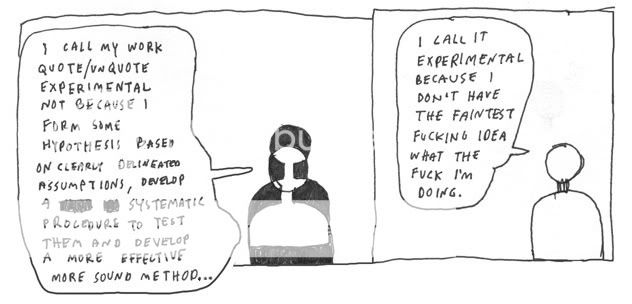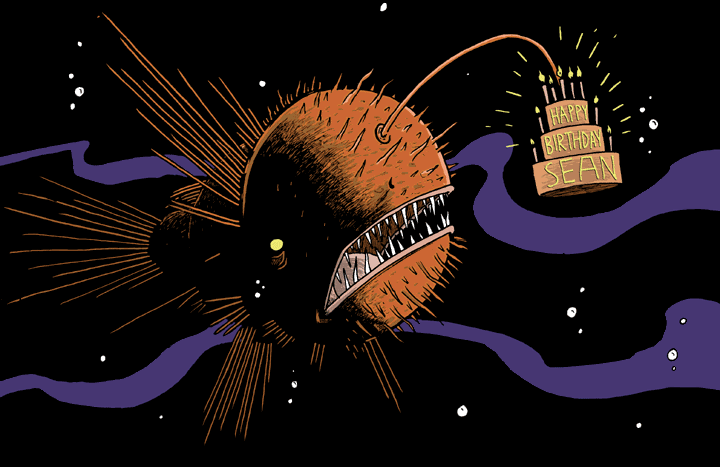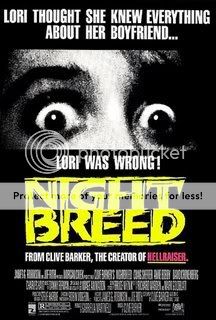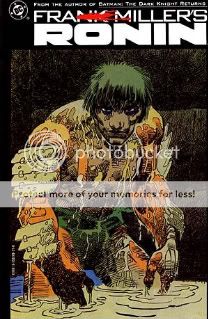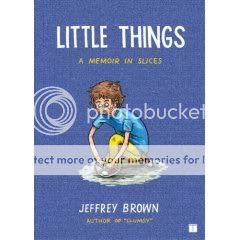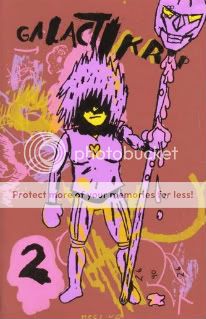Archive for April 30, 2008
Carnival of souls
April 30, 2008* Big, sad news for film and TV blogospherians: Matt Zoller Seitz, proprietor of the best film and TV blog on the web by a country mile, The House Next Door, is retiring from journalism and criticism to become a full-time filmmaker. Frequent co-blogger Keith Uhlich will take his place as editor of the site.
* At his official website, there’s another huge interview with Clive Barker. He announces a new, wholly original upcoming comic book project with his frequent publisher IDW, touches on his upcoming film projects, his paintings, the delayed release of Midnight Meat Train, and Abarat Book 3, but the bit I was most interested in, and happiest to read, was about his voice. If you’ve listened to any interviews with the man lately, quite frankly he sounded terrible, even more gravelly than usual. Turns out he had benign polyps on his vocal cords that have since been removed, making it easier for him to talk, sleep, and breathe. I sure do wish him well. (Via Dread Central.)
* Actresses Shauna MacDonald and Natalie Mendoza will both be returning for The Descent 2, which is…interesting.
* There’s a new Incredible Hulk trailer out there, and I know I’m supposed to say I’m soooooo over this movie (and Edward Norton), but I’m not. I want to watch CGI Ed Norton smack around CGI Tim Roth and I don’t care who’s feuding with whom. (Via Arrow in the Head.)
* B-Sol at the Vault of Horror serves up Part 2 of his look at the history of the modern zombie movie, starting with Dawn of the Dead and working its way through the Italian zombie flicks and the splatstick horror-comedies of the ’80s.
* Finally, Bryan Finoki muses at length about the physical and aural architecture of America’s torture chambers. (Via Andrew Sullivan.)
Comics Time: Black Ghost Apple Factory
April 30, 2008Black Ghost Apple Factory
Jeremy Tinder, writer/artist
Top Shelf, 2006
48 pages
$5
Jeremy Tinder’s debut graphic novella Cry Yourself to Sleep displayed a knack for slightly off-kilter observational humor, a fine grasp on cute character designs, and an entertaining way of combining the two. Stripped of that longer effort’s stabs at coaxing something deeper out of the yuks, BGAF feels slighter (is slighter, I suppose), but compensates for that by reading like a funny Jeffery Brown convention mini. Several of the short strips contained here mine familiar “cute animal is actually a vulgar cad” territory to laugh-out-loud effect–I particularly liked the shot of a nude woman fellating a bunny rabbit with such enthusiasm she looks like she’s eating his crotch. The stand-out strip, though, is the most serious one, which centers on a love quadrangle involving a lovelorn elephant. In its eight pages of anthropomorphized friends/lovers sharing one last bittersweet night before a separation, you get something that reads like half-Chunky Rice parody, half-Chunky Rice tribute. That’s a pretty enjoyable combination for this reader.
Carnival of souls
April 29, 2008* Tom Spurgeon interviews Comic Book Legal Defense Fund Executive Director Charles Brownstein about the dismissal of the Gordon Lee case. As I read the interview I thought of a different kind of dismissal the case received–from a former coworker of mine who, when word of the first charges first broke out, sneered that the Nick Bertozzi comic involved was pornography, that Lee deserved what he got, and that the CBLDF should never have taken the case. Not to put to fine a point on it, but suck on it, schmuck.
* Film scholar and Tolkien-film expert Kristin Thompson weighs the enthusiasm for his new Hobbit gig expressed by director Guillermo Del Toro in this MTV interview and elsewhere against the skepticism expressed by Salon’s Andrew O’Hehir. If O’Hehir’s piece stuck with its initial focus on Del Toro’s previously voiced distasted for heroic fantasy, or a critique of his existing films, I’d be right there with him, but instead it veers off into things that really have nothing to do with the potential quality of his Hobbit film, like the fact that lawsuits had been filed and Peter Jackson is successful.
* David Bowie’s legendary live set from a 1972 gig in Santa Monica is being officially released!
* Sea monsters in Manhattan! It’s an inflatable art piece by Joshua Allen Harris. (Via And Now the Screaming Starts.)
Carnival of souls
April 28, 2008* Clive Barker made some news at Fangoria’s Weekend of Horrors convention this past weekend regarding his “Books of Blood” film series. In addition to the upcoming Midnight Meat Train and in-the-works Book of Blood, Barker announced that Anthony DiBlasi has been tapped to write and direct the long-gestating adaptation of “Dread,” once again confirmed the also long-gestating plan to adapt “Pig Blood Blues,” and revealed that the fifth film in the series will be an adaptation of an unlikely choice (to me at least), “The Madonna.”
* Real life horror: An Austrian man kept his daughter prisoner in his windowless cellar for 24 years–along with the seven children he fathered with her through rape. All of this was unbeknownst to the man’s wife, supposedly. The story is so horrifying and unbelievable that it is, well, hard to believe, and I wouldn’t be surprised if initial reports turn out to be substantially inaccurate. But for now, here is your quote of the day:
Once inside the dungeon, police reported, they found all the passages extremely narrow, the ceiling is no higher than 5ft 6ins (170cm) and the floors uneven. They have found a makeshift shower room, cooking rings for the secret family to heat food, and a room lined entirely in rubber whose use is unknown.
(Via Keith Uhlich.)
* Go, look: An Anders Nilsen comic strip!
* Water monster news: Scientists are defrosting and preparing to examine the 34-foot colossal squid they found a while back. (Via Rob Humanick.)
* Finally, Fantagraphics has a pair of incredible deals up on their website: Get a set of all seven (totally, totally awesome) Love & Rockets digests for $85, and/or a set of all ten volumes (so far) of Mome for $100. Either option is such a terrific gift idea it’s not even funny.
Comics Time: Batman and the Monster Men
April 28, 2008Batman and the Monster Men
Matt Wagner, writer/artist
DC, August 2006
144 pages
$14.99
A retelling of the first Batman story to involve superpowered antagonists way back when, Batman and the Monster Men would be the baseline of quality for Batcomics in a better world than this one. It’s unlikely to stick in your craw in terms of its depiction of Batman’s sadness or mania, which for me at least is the effect achieved by the best Batman stories. Nor does the scripting necessarily rise above the usual comic-book treatment of such stock figures as Mad Scientist, Gotham Mobster, Spunky but Naive Heiress, Crooked Commissioner and so on. The narration tends to spell out what’s happening and why, and the prose isn’t stylish enough for me not to be bugged by that. And Wagner’s art is sometimes startling crude.
But–well, if you’ve stuck around long enough to hear the “but” in the first place, my guess is this book may be for you. Reason number one would be Wagner’s art, crudeness and all. His Batman is a big hunk of marble that throws itself at its targets with a real wallop. Though we’re about as far from Paul Pope’s fashion-textbook realism, the combination of Wagner’s meaty design and Dave Stewart’s plain black and gray color scheme for the outfit truly makes Batman feel like a big, fast guy who puts on a creepy outfit to punch people in. Given that the threat in the story is basically three or four big huge mutants who punch people too, the effect is sort of like watching a Kimbo Slice streetfighting video on YouTube. That’s pretty much how I want a Batman comic to feel.
Wagner also somehow pulls off the delicate alchemy of the “detective” aspect of Batman’s idiom, having the character follow a trail of clues that we of course would never trace to the same conclusion but never coming across as manipulative or shoddily constructed. If the whole thing kind of pales in comparison to Frank Miller and David Mazzuchelli’s Batman: Year One—the project to which it seems meant to be a sequel in terms of look, tone, and time frame—it’s also astute enough to fairly accurately ape that feel in the first place. Even the occasional bizarre and wonky facial expression or disproportionate body harkens back to the primitive Golden Age artists of yore. If I were presented with Batman comics like this on a regular basis, unspectacular but entertaining and satisfying efforts akin to a good solid Law & Order episode, I would be a very happy Batfan indeed.
Happy happy birthday baby
April 27, 2008My present from Matt Wiegle!
Carnival of souls
April 26, 2008* Guillermo Del Toro is directing The Hobbit and its sequel. I don’t know how to feel about this.
* I am at least enthusiastic about the idea of the second film in this particular package, which lots of people seem really confused about but which seems to be pretty clearly about both Gandalf’s doings when he wasn’t hanging with the dwarves during the events of The Hobbit proper and the subsequent doings of, I’m guessing, Gandalf and Aragorn prior to the start of The Lord of the Rings. That’s what I got out of Del Toro’s interview on TheOneRing.net, anyway. (Via Kristin Thompson.)
* “Eli, Eli, lama sabachthani?” Absolutely hilarious.
* Battlestar Galactica‘s Nicki “Cally” Clyne blogs her (spoilery, duh) thoughts on last week’s episode.
* Tom Spurgeon thought the New York Comic Con was a terrible place for people who enjoy comics.
* The Onion A.V. Club’s Scott Tobias has a piece on The Blair Witch Project, the scariest movie I’ve ever seen, that’s one of the better things I’ve read on the movie to date. (Via Keith Uhlich.)
* Here’s the second half of Jimmy Kimmel’s interview with Lost‘s Carlton Cuse and Damon Lindelof. I like the tone of it better than the first half.
* Final Girl’s Stacie Ponder presents a Clive Barker edition of her regular feature, Awesome Movie Poster Friday.
* Ken Parille has put together a striking collection of images to illustrate the influence, unconscious or otherwise, of cartoonist Daniel Clowes on cartoonist Rich Tommaso.
* Jordan Crane’s cover for Uptight #3 is fantastic.
* Finally, this week’s Horror Roundtable is about the one horror-movie prop we’d most like to own. I’ll give you three guesses as to what mine is, and the first two don’t count.
Comics Time: Ronin
April 25, 2008Ronin
Frank Miller, writer/artist
DC, 1984
302 pages
$19.99
If The Dark Knight Strikes Again is Frank Miller’s brain on SPX, I suppose Ronin is Frank Miller’s brain on Shogun Assassin. I’d say Lone Wolf and Cub proper or some other manga touchstone, but the thing is that my own comparative ignorance of Japanese comics and Miller’s enormous influence on Western ones make it hard for me to see evaluate this formally as anything but a Frank Miller Comic that happens to use samurai and Akira-style science fiction.
It’s a very good Frank Miller Comic in fact. Back then his art had this doodly/sketchy quality—lots of little loops and bubbles and curlicues—that had yet to solidify into the hyperrealist noir of the first Sin City chapters in Dark Horse Presents and thence to recede to the chunky bigfoot self-satire of DKSA or the later Sin City books. It’s a bold style, perfect for conveying enormity by expanding the blobby details to the edge of the page or isolating action by stripping them away and letting the remaining figures slash through them. It’s also beautifully colored by Miller’s now ex-collaborator Lynn Varley; no one has used greens this effectively before or since.
Storywise it combines the familiar Japanese pulp tropes mentioned above with the uniquely Millerian idiom of topless black bondage Nazi gangs (cf. The Dark Knight Returns, Sin City), evil corporations painted with an hilariously broad satirical brush (cf. Hard Boiled), and sinister omnipotent female computer programs (cf. Martha Washington–man, if in some future FM Batman comic the Batcomputer ever gets referred to as “she,” watch out). But moreso than in any Miller comics save perhaps his collaborations with David Mazzuchelli, there’s a refreshing space left for the human element. While there’s obviously a lot of “he is the Hero, he is everything” to be found here, much of the plot is driven by the comparatively quotidian doings of the Aquarius Complex’s worker bees: middle management, staff psychiatrists, laborers pissed off at the treatment of the fellow workers, an idealistic scientist and his security-guard girlfriend whose story of success-driven estrangement would fit nicely into a late-’90s period piece about a dot-com startup. So it’s easy to forgive some narrative lapses, like a jarring bit of told-not-shown infodumping about how the ronin entered the modern world whose raison d’etre only becomes apparent at the end of the story, and simply focus on the pleasures of the art and the tempered-gonzo writing. Capping it all off is a brancinglysudden ending and final image of triumph-through-simply-existing that I really wish more genre comics would ape. I will enjoy rereading this comic every four years or so until I die.
Lost: A tale of two interviews
April 24, 2008Yesterday, two interviews with Lost head writer Damon Lindelof and showrunner Carlton Cuse popped up that seem almost tailor-made to be illustrative of two conflicting schools of Lost fandom.
On the one hand you have comedian Jimmy Kimmel’s interview with the pair for TV Guide. This is the first question he asks:
The island heals some people and doesn’t heal others. For instance, Ben needed an operation from Jack to beat cancer, but it seems like Sawyer gets injured every sixth episode and by the next, he’s fine. Is that just a TV thing?
The last sentence kind of skews the question in a process-oriented direction rather than just an “OMG what’s going on???” one, but I still think it points to the outlook of the kind of fandom that has me so flummoxed lately. To the extent that they do have considerations other than plot those considerations are still focused on logistical issues–trying to figure out why and how things happened behind the scenes. Simply mulling over and discussing the emotional, intellectual, and certainly the aesthetic impact of what we’ve seen doesn’t enter into it. In many ways, it’s like interviews with superhero comics writers, where nearly all the questions are dedicated to either “What’s gonna happen to Wolverine next?” (in-world questions) or “How did you decide to do that to Wolverine?” (making-of questions), with no real critical response to speak of (unless you count “tearing the internet in half,” whether positively or negatively, as a qualitative observation, which you shouldn’t).
But Kimmel’s interview gets at some of these distinctions itself. For example, there’s this blockbuster section:
Kimmel: People come up to you all the time with theories. Has anyone come close to cracking the code?
Cuse: I think there are two assumptions that people make that are incorrect. One is that the whole answer to Lost reduces down to a sentence. It’s not like searching for Einstein’s Unified Field Theory. And the second is that you have enough information to “crack the code.” The flash-forwards completely changed your notion of the show. So how could you do some accurate theorizing before you even knew those existed?
My sentiments EXACTLY! Seriously, it’s almost eerie to be echoed by one of the show’s head honchos just, like, two weeks after this first even occurred to me. But the best part of Cuse’s quote is that it goes beyond refuting the Theorizers on a logistical level (you can’t possibly know because you don’t have all the information yet) and rejects that approach on a philosophical level as well (you can’t possibly know because it doesn’t work that way anyway).
Furthermore, when Kimmel presses the issue, Cuse responds:
Even though we get asked a lot of questions about the mythology, Jimmy, we’re really trying to write a character show. We spend about 80-90 percent of our time talking about how the characters are lost in their own lives as people. The mythology is kind of the frosting on the cake.
About the only discussion of Lost I’ve seen that treats the show this way was from Andrew Dignan’s now-defunct weekly Lost reviews at The House Next Door, which really bums me out. Now, I don’t think the show would be as important to me if the mythology weren’t there–as a character show it’s not up there with the great HBO dramas–but this is such an amazingly undervalued way of approaching the series–including by the creators themselves, no matter what they say to the contrary, so long as they continue to participate in stunts like USA Today’s “post your theory, get comments from the producers” contest.
(Now there is, of course, the “Lindelof’s Mom” viewer, who supposedly tunes in to the show to see who hooks up with whom and cares not one whit for the monster or the Hatches or any mythology aspects. But as a friend of mine pointed out to me, the kinds of people who fixate on “who falls in looooooove” are almost as bad as the clue-hunters, and they’re certainly a different beast than people who consider the overall effect of the show rather than the romance aspect alone. Theorizers and Shippers–the Scylla and Charybdis of contemporary genre fiction.)
And I also appreciated this bit from Lindelof, regarding the freeze-framed, digitally processed search for “clues” in every episode:
We would love in moments like that to go, “Yes. We knew we’d be introducing the idea of the Dharma Initiative in the second season premiere and we wanted people to go back to the pilot and see that the symbol had been burned into the fuselage.” But if we had known, we wouldn’t have done it in such an oblique way. Sawyer would’ve went [adopts Southern twang], “Hey, what’s this?” We want people to see our Easter eggs.
This is a separate aspect of clue/theory-based fandom that irks me: the tendency not just to see hoofprints and think of zebras instead of horses, but to invent zebra prints when there aren’t any there. Perhaps the most infuriating discussion about Lost I’ve ever had took place on a message board I hang out on, where I spent two or three weeks being told that there’s no way baby Aaron could be one of the Oceanic Six, basically because he wasn’t a ticketed passenger. Now, the label “Oceanic Six” is, in the world of Lost, a media-generated nickname for the survivors, so for Aaron to not be considered one of them would therefore mean the international news media ignored a baby born on a deserted island to a plane crash survivor–basically the greatest human-interest story ever–on the kind of technicality that only people who sit around making anagrams out of supporting characters’ names would appreciate. The adamant refusal to consider basic tenets of human behavior, instead focusing on clues and rules and regulations like the show is a board game, is so baffling to me.
Interview number two is conducted by the Onion A.V. Club’s Noel Murray. This interview is distinguished from every other interview I’ve seen with Lost creators, including the two I myself have conducted, in that it doesn’t as a single in-world question. Also, the making-of questions aren’t all variations on “do you know where this is going?”, which is in a way just an in-world question in disguise. The resulting answers make for fascinating reading, and I’m so enthusiastic about it I’m basically going to reproduce vast swathes of it while encouraging you to click over and read it yourself.
For example, here’s Lindelof on the difference between flashforwards and flashbacks as storytelling mechanisms:
…whereas the flashbacks before had been an emotional storytelling technique—like, “Here’s how Sawyer became a con man, here’s the time that Jack ratted out his father, here’s when Kate held up a bank”—on a story level, they weren’t that complicated. They were sort of the one thing the audience could grasp onto, no matter what sort of wackiness was happening on the island. The flash-forwards are the exact opposite of that. When you see [Character X] in the future killing people for [Character Y], that’s all story. Or when you see [Character A] being approached by [Character B], that’s all story. So the show actually becomes vastly more complicated.
All the flashforwards so far have shown the characters involved in extremely tense and discomfiting places emotionally so it’s easy not to notice that they’re now plot pieces as well as character pieces, but this is a point well taken.
Then there’s Cuse on the different difficulty levels, for want of a better term, for the show’s mysteries:
I also think that it’s rewarding for the audience to not always be frustrated and behind. We have certain mysteries on the show that we hope the audience figures out on their own, and can have the satisfaction of saying “Aha! I knew that! I knew that the guy on the boat was going to be [Character Q]!” But there are other times when we have real surprises, like [Character U] shooting [Character V] and [Character W], where we go to great pains to make sure that nobody sees it coming, so you’re genuinely surprised. We intentionally mix up the degree of difficulty in solving the puzzle.
I still find it immensely frustrating when the show is spoiled by its own opening credits, but again, this is a point well taken.
The pair also talk candidly, and to my mind somewhat disappointingly, about the impact fan reaction can have on the story itself. While they both disavow Lost messageboards as overly plot-centric and nitpicky, they also admit that the public reception of characters–they call this “market fluctuations”–can lead to their premature exit from the show. So too can outside considerations like actors simply wanting not to live in Hawaii anymore, which bums me out enormously, as such things have ever since I found out that the Frankie Pentangelli role in The Godfather Part II was originally supposed to be Clemenza. On the other hand, actors who really click in a role sometimes see their parts get beefed up, and for whatever reason I have no problem with that–I suppose because it’s an issue of collaborating artists, rather than a business concern or an audience concern.
There’s a lot more, including the now ever-present discussion of how having a set endpoint has altered and reinvigorated the storytelling dynamic, an interesting passage about how the DVD/download viewing model is really going to be the norm once the show ends and the actual week-to-week airings are a historical fluke by comparison. You should read the whole thing.
(Links via Whitney Matheson)
Carnival of souls: Special “Frank Milla Thrilla” edition
April 24, 2008* A whole bunch of Frank Miller/The Spirit news came out of New York Comic Con, including some more posters and an enjoyably Sin City-ish teaser trailer. (Via AICN.)
* For my money the most interesting Miller tidbit has to do with another project entirely: Miller himself is hoping/planning to direct an adaptation of his and Geof Darrow’s gonzo sci-fi masterpiece Hard Boiled. As MTV points out, this project was originally associated with Nicolas Cage and David Fincher. (Also via AICN.)
* And at Entertainment Weekly, Miller and his producer Deborah Del Prete talk turkey about the Spirit adaptation, while Miller reveals he’s 122 pages into a new book that’s a “love letter to New York”–presumably not Holy Terror, Batman!, then–and that he’s finished writing Sin City 2 with an eye on an eventual third film as well. (Via Kevin Melrose.)
* Speaking of films that irritate Ron Rosenbaum, Uma Thurman tells MTV that Quentin Tarantino is indeed working on that big final all-in-one deluxe DVD version of Kill Bill, aka The Whole Bloody Affair, AND at least one of his proposed anime prequel/sequel/whatevers involving the KB characters–the latter will be used as a bridge/intermission to create the former. Based on Tarantino’s previous statements and Thurman saying she hasn’t done any voice work for the cartoon, it seems like Bill will be the subject of the new material rather than the Bride. (Via Rob Bricken at Topless Robot.)
* Ammon Gilbert of Arrow in the Head pays homage to one of the two great ultraviolent Communist-invasion action films of the ’80s, Red Dawn. (That’s the one involving teenaged Patrick Swayze, Charlie Sheen, C. Thomas Howell, Lea Thompson, and Jennifer Grey avenging the imprisonment of Harry Dean Stanton–and who wouldn’t?–not the one involving Chuck Norris shooting people in shopping malls.)
* The Blot‘s Tom Neely keeps on killin’ the game with his weekly comic strips. Goddammit, look at those palm trees.
* Water Monsters in the News: Loren Coleman notes a report of an alligator in a New Hampshire pond, which is neat enough, but in so doing he breaks down the differing types of unusual-alligator reports: stray pets or zoo animals vs. expanding habitat vs. actual out-of-place breeding populations vs. genuine cryptid lake monsters. Dreamy stuff.
* All Too Infrequent T-Shirt Blogging: Whitney Matheson notes that CNN.com now has T-shirt-making functionality for some of its video-news headlines. That is very bizarre and very cool.
* Finally, I hope to have a nice Lost post up later today in time for the return of the show–I was gonna include that stuff here but it probably merits its own post. So stay tuned.
Comics Time: Little Things
April 23, 2008Little Things
Jeffrey Brown, writer/artist
Touchstone/Simon & Schuster, March 2008
352 pages
$14
It had been a while since I read a full-length Jeffrey Brown comic starring Jeffrey Brown, and I’d forgotten what a unique experience a Jeffrey Brown autobio page is. Reproduced at roughly the same size at which they’re drawn, Brown’s pages are almost always stuffed with six square panels, which are themselves crammed with penned detail. But despite containing so much visual information, the casual feel of Brown’s line and portraiture make the page come across more mellow than manic. Meanwhile, and particularly when compared to the many other sketchy (by design or necessity) slice-of-life efforts that have sprung up in Brown’s wake, his pop-eyed characters pop from their backgrounds, which themselves feel like fully realized and inhabitable spaces. The total effect is really accomplished and unique, and it turns out I missed it quite a bit.
This is the part of the review where I was gonna argue that in these ways the art mirrors the story, or nonstory, presented in the book itself: a sea of detail saved from unpleasant obsessiveness by a breezily directionless presentation, against which notable specifics stand out. This observation has the virtue of being true, but I feel like reading that much into what’s going on sort of defeats the purpose of the book. While Brown argues in his introduction that the point is that tiny, seemingly insignificant moments–coffee with friends, awkward movie-watching experiences–can take on the same importance as truly life-changing events–gall-bladder surgery, witnessing a horrific car crash, meeting the father of the mother of your child–to me the book ultimately demonstrates something slightly but vitally different: Those insignificant moments remain insignificant, yet occupy a disproportionately high rank in our mental catalog of memories, and the resulting stew of momentousness and meaninglessness is in the end what makes our lives what they are. Both are indispensable.
Sean goes Topless
April 22, 2008My debut post at the wonderful nerd-culture site Topless Robot is up: The 11 Most Awful Songs from Geek Movie Soundtracks. I’d say “enjoy,” but I’m not sure that’s applicable.
Carnival of souls
April 21, 2008* I’ve seen a lot of OUTRAGE from horror fandom about the recent successes of PG-13 horror movies, perhaps best represented by the Prom Night remake from a few weeks back. Most of it consists of mouthbreathingly simplistic “BLOOD AND TITS EQUALS WIN”-type extreme-mongering rather than any kind of informed consideration of whether PG-13 movies might possibly be scary. But B-Sol at Vault of Horror takes an entirely different view of the problem with PG-13: They’re slasher movies explicitly geared at young teenagers.
* Jim Henley defends 24 against the accusation that it’s directly responsible for torture at Gitmo and elsewhere, as recent reports have claimed. I totally agree with Jim: as with other cases involving movie-inspired violence, I think it’s a case of people predisposed to violence gravitating toward violent art, not violent art inspiring violence in the first place. And while I don’t give a good goddamn about the show itself, some regular viewers in Jim’s comment thread point out temporal discrepancies in terms of what was going on in the series by the point it was supposedly inspiring torture techniques.
* Scott Pilgrim creator Bryan Lee O’Malley reviews Cloverfield! I think he’s right about the film’s visceral impact and wrong in saying the characters aren’t vapid (man, that’s kind of leaving things wide open for people with the same complaint about SP, isn’t it?), but you’ve gotta love his disclaimer:
Note to complainers: don’t take this as an invitation to pontificate on why you hated this movie, because I don’t actually care
* This week’s Horror Roundtable is all about horror movies we remember watching as kids. Between the Roundtable proper and the comment thread, the moral of the story is clearly that everyone loves The Monster Squad and The Blob.
Comics Time: Galactikrap 2
April 21, 2008Galactikrap 2
Brian Chippendale, writer/artist
self-published, October 2007
72 pages
$8
This is what those “fun” superhero comics that nobody but predominantly superhero-comics bloggers reads would look like in an alternate universe where Gary Panter took over as Marvel house artist instead of John Romita Sr. and Los Bros Buscema following the departures of Jack Kirby and Steve Ditko. The major difference, of course, is where in those books the action-humor blend is the primary selling point, here it’s simply the tool Chippendale uses to set up the action beats and environments that are the meat of his cartooning. The yuks and fights are the means to an end, not an end in themselves, but they also happen to be really really crackerjack, which is more than you can say about this book’s Big Two brethren.
Plotwise, this is a follow-up to Chippendale’s earlier Battlestack Galacti-crap, a story of two tribes (cue Frankie Goes to Hollywood) of costumed weirdoes battling it out over the right to sell cupcakes in a particular area of their sci-fi city. It’s exactly as nonsensical as it sounds, which is totally fine because the point is the drawing, and man, it’s a pip. This issue kicks off with a brief silkscreend color section that evokes the full-color openings of manga volumes, a comparison subverted here by the supreme ridiculous of the subject matter (one of our warring tribes, Teamy Weamy, is debating whether to change their name to Team Tomb or Team Tummy). The rest of the comic comprises three separate, vaguely interlocking vignettes, each defined by the way they use sequences of panels to pace action. In the first (back at the cupcake stand from the first issue) a bug-laden “bugcake” is lobbed past a stunned onlooker at the head of a disgruntled customer; Chippendale draws the action out over several panels to call attention to its kinetic silliness. This is in contrast to the next big bit, in which panel after panel is left silent while two characters are placed on hold as they call a credit card company to find out why one of their cards has been denied–here the drawn-out sequencing conveys boredom rather than action. Things kick into high gear in the second section, which involves a pair of super-types infiltrating an underground lair and battling robot-type dudes. Chippendale’s chunky, crunchy line is a surprisingly effective canvas for action choreography, making the space in which the action takes place feel solidly constructed and lived-in while lending a certain palpable oomph to various ninja stealth antics, laser dodges, and one really memorable blast at a bad guy. the third and final sequence is mainly an excuse to create a convenience store shaped like Godzilla called Snackzilla, I guess, but it too has a laugh-out loud depiction of slapstick involving a bunch of characters getting bonked on the head with a baseball bat and sent tumbling down a hole in the floor by a secret member of a rival gang. After a funny, deadpan two-page bonus comic by Ben Jones about a dog who will become the Chosen One but at this point mostly stands around with his tongue lolling out, the comic ends with another two-page color section; as with the first issue, this finale displays Chippendale’s knack for drawing figures in freefall, but this time uses it to set up a funny gag about one falling character remembering he can fly mid-plummet.
The character designs are all funny and easy to parse–I sort of want to see these folks cross over with the gang from Powr Mastrs; the environments, particularly in a trio of stand-alone pages toward the end of the book, are immersive and mysterious; and since Chippendale is working with basically one or two large panels per page it’s probably a lot easier than Ninja or Maggots for your average civilian to follow. This is the kind of minicomic you’ll read from cover to cover each time you come across it wherever you keep your minicomics. If you spot this at a con you should buy it.
Carnival of souls: special “quality over quantity” edition
April 20, 2008* Todd VanDerWerff at the House Next Door has posted a very thoughtful and in-depth review of Friday’s excellent Battlestar Galactica episode.
* Tom Spurgeon does another one of his must-read review rampages.
Carnival of souls
April 19, 2008* Big news: The Gordon Lee case has been dismissed, presumably due to egregious prosecutorial misconduct. This is a big day for the Comic Book Legal Defense Fund and a big day for comics, a medium that stands on shaky ground with regards to free speech issues. (Via Tom Spurgeon.)
* Fangoria speaks to Clive Barker about the current status of the Hellraiser remake, his Harry D’Amour/Pinhead epic The Scarlet Gospels, the next Abarat book, and the film adaptation of The Thief of Always.
* Tom Spurgeon reviews Joshua W. Cotter’s knockout Skyscrapers of the Midwest.
Comics Time: Forlorn Funnies #5: My Love Is Dead/Long Live My Love
April 18, 2008Forlorn Funnies #5: My Love Is Dead/Long Live My Love
Paul Hornschemeier, writer/artist
Absence of Ink, 2004
80 pages
$10.95
Buy it from Copacetic Comics still, maybe
Originally written on July 8th, 2004 for publication in The Comics Journal
The fifth installment of Paul Hornschemeier’s personal anthology series is a transitional work of sorts, a midway point between the publication of the author’s formidable graphic novel Mother, Come Home (the serialized installments of which completely took over Forlorn Funnies‘ previous three issues) and his upcoming entrée into the art-comix big time when Fantagraphics begins publishing the series. (This is the alternative comics equivalent of a WB starlet getting that phone call from Playboy–you’ve made it, baby!) Perhaps Hornschemeier himself sensed the in medias res nature of this project. It’s his most direct effort to date in forging a middle way between his satirical and melancholy modes. Granted, separating the two physically may seem an odd way of linking them, but the link isn’t any less clear for that.
As the book’s subtitle suggests, My Love Is Dead/Long Live My Love is indeed divided into two sections, one “funny,” one “forlorn,” each printed at a 180-degree rotation from the other. Each section has its own “front cover” featuring the appropriate half of the subtitle and a mood-specific image and color scheme (as well as, cleverly, the book’s bar code and ISBN information–this way there’s now way to guess which half Hornschemeier considers “the back of the book”). At the spread at the center of the book, where the two sections meet, we find two pages’ worth of rival “About the Author” material, one of which solemnly enumerates Hornschemeier’s C.V. and the other of which features a lengthy explanation for its use of the phrase “butt smear.” (You’re all bright people, so I’ll leave it up to you to guess which is which.)
Baroque conceits such as this are nothing new for Hornschemeier–you may recall that the entirety of Mother, Come Home is supposed to be the introduction to a novel of which we only see the first chapter’s title page. It’s fun to watch Hornschemeier at play in the fields of the formal, but what excites one most about FF5 are the cartoonist’s visual and storytelling skills, which continue to expand at an alarmingly brisk rate.
Perhaps the best example of this is the emergence, fully formed, of a vocabulary of the monstrous a la Woodring or Brinkman. These strange creatures and the psychedelia-by-way-of-graphic-design wilderness in which they live are used to great effect on both sides of the forlorn/funny equation. In the former case (“Underneath”), a furry, Yeti-like behemoth responds to his growling stomach by diving under the sea, assaulting one of the creatures he finds there, and devouring one of the creature’s young as its sibling and parent look on. The attacker arrives back on dry land only for its stomach to rumble yet again; he glances at the sea, and in the subsequent panel is nowhere to be found. The sequence is wordless, the creatures expressionless, but the horror inherent in the sea-creatures inability to protect itself or its children is palpable and chilling. As it trundles over to comfort its surviving offspring when the land-creature swims away, we wonder what it can possibly say to provide solace or safety; moreover, when we realize the land-creature has gone back underwater, we know that neither is in the offing. The humiliating powerlessness of parents in the face of overwhelming violence is usually the subject of only the finest literature (on TV, only The Sopranos goes there; in comics, you’re hard pressed to find explorations of the topic outside historical efforts like Maus and Safe Area Gorazde); it’s both jarring and inspiring to see this painful aspect of human existence broached in a monster comic.
On the funny side of things (“Ditty and the Pillow Plane”), the monsters are used (not surprisingly, as we’ll soon see) to explore similar themes. While the two title characters float along in a manner reminiscent of Mother‘s opening sequence, strange creatures bite each other, ride each other, attempt to devour each other, and run past the frame while on fire. Ditty (whose eyes are x’s) and the Pillow Plane (who has no eyes to speak of) grab a snack amidst the chaos, and the sequence concludes with this exchange: “Is civilization a cancer?” “Of the liver, Ditty.” This seems as accurate an assessment as any, given the absurd pandemonium going on around them.
The notion that something’s just sort of wrong with civilization and that we’ll never set it right is the funny side’s major preoccupation. This sentiment is frequently expressed in the broadest of terms–phrases like “Has it all been that senseless?” “Is it pointless to laugh?” “Fuck it all anyway!” and (especially) “Whatever, dude” echo one another from strip to strip. A trio of overt political cartoons help make this case as well. “Everyone Felt It” (its title emblazoned on a striking, stark black background) skewers the vague everybody-hurts semi-soul-searching the U.S. occasionally indulges in in times of tragedy. The star of “America, Your Boyfriend” is a MODOK-esque lunkhead who kicks the crap out of anyone who dares look askance at his SUV-driving, beer-swilling lifestyle. Personally, I believe that our country’s most devoted enemies, in their drive to quite literally revive the Middle Ages, have problems unrelated to our own nation’s admittedly troubling obsession with luxury vehicles, but the point is made clearly and, perhaps more importantly, hilariously. “The World Will Never Be the Same” depicts various people behaving like racist, sexist, xenophobic, elitist, patronizing assholes both “THEN” and “NOW,” 9/11 being the unspoken line of demarcation between the two. The strip is similar in effect to an oft-reproduced sequence from Art Spiegelman’s In the Shadow of No Towers, and if the simplicity of the message of both is a little disconcerting (gee, America still isn’t perfect? Bush lied!), Hornschemeier’s iteration is more effective both for the vicious specificity of its targets and his willingness to implicate himself with his send-up of patronizing artsy-fartsy types. (“Oh, absolutely, his work is really making a difference,” says one such gallery-attending schmuck as a presumably homeless man walks by.)
The excess of the artiste is another prime target. “Stupid Art Comics Are Stupid” is a gratifyingly reductive assault (at times, a physical one) on the pretensions of the modern artist, depicted alternately as a sex-obsessed phony or an empty-headed dilettante. Its follow up, an essay entitled “Stupid Art Comics May Be Stupid, But ‘Stupid Art Comics Are Stupid’ Is a Complete Waste of Time,” is written from the point of view of a critic enraged both by the earlier piece’s unsurprising “surprise” insights into the human condition and its creators insistence on designing it so that it can only be read if held upside-down in front of a mirror. A multi-page sequence entitled “Artist’s Catalogue” deploys a slew of anti-art gags, including several pages that are simply blank and a reprint of the meticulous, highly intellectual plans and sketches for what turns out to be an “I went down on your mother” joke. (Fans of a certain Mozart/Bach-inspired Spinal Tap song ought to be pleased.)
With Long Live My Love so fixated on depicting a world going to hell in a handbasket as society’s supposed coalmine canaries, the artists, jerk themselves off, it’s up to My Love Is Dead to make more personal, though equally universal, points. A strange, untitled sequence involving a man, his grandmother, and a blood orange is difficult to unravel–I’m still not exactly sure what’s going on, or more specifically what is about to go on–but the man’s sweat, tears, and self-contradictory statements speak volumes about the power and terror of family love. “We Were Not Made For This World,” a sci-fi parable about a robot seeking the source of its creation even as the desert through which he marches slowly erodes the automaton’s ability to continue, is reminiscent of any number of similar SF meditations on loneliness, from Martin Cendreda’s memorable minicomic Zurik Robot to Stephen King’s eerie short story “The Beach.” Hornschemeier’s skill with both art (depicting with mathematical precision the granules of sand that are inexorably eroding the robot from within) and words (“He focuses on the horizon and tries to think it is beautiful”), however, give the story its own tragic grandeur. Most impressively of all, in “These Trespassing Vehicles,” Hornschemeier uses a moment of random, catastrophic violence to center a story that encompasses the entire lives of its characters with daunting, heartbreaking totality. There’s even room for a thoughtful twist ending, itself emerging from a life’s irreversible turns. The story itself neatly mirrors the strength of Hornschemeier’s work in general. Some moments may overshoot, others may undershoot, but the ambition is always grand, and thanks to the keenness of the author/artists’s eye for detail amidst his expansive vision, so too is the execution.
I’m so Lost
April 17, 2008By participating in and perpetuating the theory-school of Lost fandom, the show’s creators no doubt think they’re fanning the flames of the Lost phenomenon. But this afternoon I got thinking that maybe they’re actually doing the show a disservice. Not because I don’t personally go in for theories, mind you–I mean that they might think they’re building buzz, and therefore ratings, for the show when in fact they might be driving potential and actual audience members away.
Here’s the thing: How many times have you heard people say they can’t follow the show, that they have no idea what’s going on, that it’s over their head? But I don’t think Lost is over anyone’s head. Strip away the intriguing sci-fi elements and occasionally baroque flashback/flashforward structure and it’s an action-adventure show about sweaty sexy people shooting things and Frenching each other on a tropical island–a very very compelling and well-made one, of course. I think the greatest trick the show ever pulled was convincing people it was over their heads by making people think that instead of simply watching and enjoying it, you need to “figure it out.” As I’ve said, you can never figure the show out based on what you’ve seen because there are still two and a half unseen seasons chock full of information that will change the big picture. So if that’s the level at which you’re engaging the show, you will always feel outsmarted by it, and for many viewers that’s going to drive them away from watching it at all.
Carnival of souls
April 16, 2008* I’ve seen the news that after a gangbusters test screening Lionsgate is preserving The Midnight Meat Train‘s full meaty title and giving it an August 1st Stateside theatrical release everywhere today, but I’m sourcing it with Jason Adams just because the title of his post is easily the greatest thing I read all day.
* Here’s news about North American screenings of two highly touted French horror movies, Inside and Frontier(s); the latter, at least, will be coming to NYC.
* Entertainment Weekly goes yard on the Edward Norton vs. Marvel Studios Incredible Hulk spat. The fact that Norton and director Louis Leterrier appear to be on the same page would seem to refute the “Norton’s a prima donna who should shut up and just read his lines” school of analysis. (Via J.K. Parkin.)
* CRwM at And Now the Screaming Starts reviews the cheeseball killer-crocodile movie Primeval. Normally I wouldn’t care, but he kicks it off by recounting the incredible, true story upon which the film is based: a gigantic crocodile from Burundi, twice the size of normal adult males and with a suspected body count of three-hundred human victims, meaning it was killing them for sport rather than sustenance.
* If all the Watchmen does is give us Rorschach action figures to buy, it will already have achieved something. (Via Kevin Melrose.)
* Finally, good news, horror fans! The Supreme Court says we can start executing people again!
Comics Time: Tales of Woodsman Pete
April 16, 2008Tales of Woodsman Pete
Lilli Carré, writer/artist
Top Shelf, May 2006
80 pages
$7
Was this a webcomic first? A series of microminis? I ask because the skill Lilli Carré shows in this anthology is so considerable in terms of its ability to build to a punchline that also doubles as an indictment of the specific brand of thoughtless waste she’s gunning for that it feels like you’re reading a best-of collection rather than a debut.
Tales consists of strips of varying length chronicling the comical misadventures of both the titular woodsman and the legendary tall-tale hero Paul Bunyan and his blue ox Babe. I’m not saying it’s a masterpiece–Carré occasionally gives into the temptation of a too easy joke, as in the first strip, where Woodsman Pete remarks upon the beauty of a pair of birds’ song and then kills them anyway; meanwhile many of her strips on Pete dealing with aging strike me as being a young person’s view of what old age is like; a lengthy section involving a future globally-warmed world where dried-up oceans leave great salt deposits behind never clicks as well as its length demands.
What I am saying is that it’s a remarkably assured book, one where even its weak spots (which strike me as less important the more I think about the collection) feel like deliberate choices rather than missteps. Carré’s thin, clear line, attractively presented in blue throughout, enables her to simultaneously cram many panels onto the book’s small pages–resulting in a bit-by-bit inch-by-inch dialogue pace that perfectly fits the stories’ shaggy-dog-tale rambliness–and give her characters an expressiveness that belies their knowingly crude design. I could sit and stare at Paul Bunyan’s hair and beard for minutes, while at certain points the shading on Pete’s hat and beard is almost tactile. The comparative realism of the animal heads mounted on Pete’s wall lends weight to what struck this particular vegetarian as a message of conservation buried beneath the black humor.
Meanwhile, the gags frequently arrive from unexpected directions. Along with his wall-mounted hunting trophies, Pete keeps row upon row of beard trimmings to mark the decades. A stuffed deer head presented as a flourish on the top of one strip is revealed to have a stuffed butt attached to it when we turn the page. When Pete calls one of his trophies his favorite, another one silently cries. In a strip called “Saturday Night,” Pete strips butt naked, dances around, then stops and falls asleep, and that’s the whole strip. It’s bracingly dry and cleverly delivered stuff.
The most impressive aspect of the collection is the unforeseen interlocking of the Pete and Paul Bunyan material. The giant lumberjack and his bovine friend don’t show up until about a third of the way through the book; when we realize what’s going on and that the images that kick off his arrival seem tied directly to the events of the preceding Pete strip, it’s a rewarding little epiphany. However, Carré fudges the details of the strips so that it’s never quite clear whether or not Pete and Paul are actually anywhere near each other temporally or spatially, which besides being a fairly complex narrative conceit for a gag-strip collection speaks directly to the larger point she’s making about the unreliable nature of memory and storytelling and the dubious prospect that these mental phenomena can actually enable true and lasting connections between different people. All this for seven bucks? Sold.



